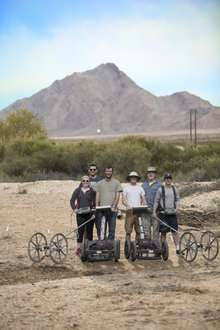A team of undergraduate researchers from Ithaca College traveled to Las Vegas to scan for subsurface cultural features at the Larder Site.
A team of undergraduate researchers from Ithaca College traveled to Las Vegas to scan for subsurface cultural features at the Larder Site—an archaeological site occupied by Native Americans nearly 2,000 years ago —as part of a preservation project along the Las Vegas Wash.
The team conducted a geophysical survey of the prehistoric site using ground-penetrating radar and a magnetometry. Ground-penetrating radar detects reflected signals from subsurface structures and plots data as profiles, maps or 3D models. A magnetometer recognizes unique magnetic properties and detects disturbances of the Earth's magnetic field.
Using the two types of sensing equipment, the team found signals that resembled what could have been semi-subterranean dwellings, referred to as pit-houses, and an excavation team on site confirmed this the following day.
Michael Rogers, associate professor in the Department of Physics and Astronomy at Ithaca College led the team of researchers in their discovery.
"For our team, this was really exciting because within two days of work we identified two houses at the site, which now changes our understanding of it," said Rogers.
Previous archeology work at the site discovered food storage pits, but no evidence of habitations at the site. The discovery of the houses confirmed that people did live at the site.
Rogers has conducted research using ground-penetrating radar, magnetometry and/or 3D laser scanning technology at a variety of historic sites from the Revolutionary and French and Indian Wars, including Old Fort Johnson, Fort Klock and Fort Hardy.
More information: For more information, see www.usbr.gov/lc/region/feature/LarderSite.pdf
Provided by Ithaca College






















